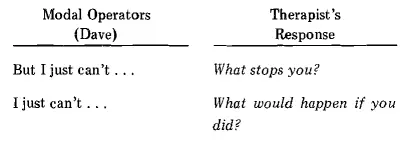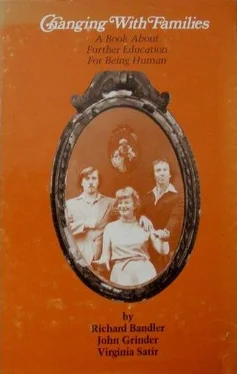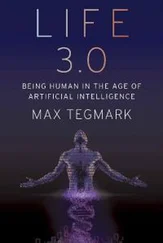Dave: I don't know ... I really don't know. I just can't.
Therapist: Dave, could you tell me what would happen if you did this?
Dave: What would happen? I don't know . . .
Therapist: Guess, Dave!
In this portion of the transcript, the therapist has made a request to Dave to try something new, something which runs counter to the calibrated communication, involving the Mind Reading and Complex Equivalence, which is going on between him and Marcie. Dave's response is to state that it is impossible to do what the therapist has asked: I just can't. Now, the therapist knows from his own experience — of looking directly at Marcie when he communicates with her — that looking directly at her when speaking to her is possible for him. Therefore, if Dave thinks that this is impossible, then his claim is a signal that he has been asked to perform an act which is outside of his model of the world and, more specifically, outside of his model of what is possible for him with Marcie. One of the patterns which has assisted us most in organizing our experiences in family therapy is our ability to detect the limits of the family members' models of the world — what acts are, literally, beyond the limits which they allow themselves. In natural language systems (verbal), there are a small number of expressions which logicians call modal operators [12] Modal operators are discussed in more detail in The Structure of Magic, Volume I, pages 69-73.
of possibility and necessity. These are words and phrases which specifically identify the limits of the speaker's model of the world. By identifying these limits, we are able to help the person involved to extend his model to include what he wants for himself and his family, to turn into a choice something which he has regarded as inevitable. In the following exchange between Dave and the therapist,

the two responses by the therapist assist Dave in extending the limits of his model to continue the process of change toward what he wants for himself and Marcie.
Next, we list some of the most common words and phrases in the English language which identify limits in a person's model and, opposite them, the two verbal challenges we have found most effective in helping to change these limits.


The therapist's challenges to these cue words and phrases, which identify the limits of the family's model of what is possible for them, have, in our experience, been extremely effective in assisting in the process of change.
Closely associated with modal operators is the type of exchange illustrated by the following part of the transcript:
Dave: Oh, no; I'd really like to, but I just can't.
Therapist: What stops you?
Dave: I really don't know ... I just can't.
Therapist: Dave, what would happen if you did?
Dave: I really don't know.
Therapist: Guess, Dave!
Often, when using verbal patterns to assist the family members in changing, we have received the reply, I don't know. We often ask them to guess. We have found that asking people to guess relieves them of the pressure to know accurately, and, therefore, they can come up with more relevant material. By responding with a congruent guess, time and again we have enabled family members to express something important about what stops them from getting something they want for themselves. When requested to guess when he claims not to know the answer to some question, the family member invariably produces an answer. The answer can come from only one place, his model of the world. Thus, his answer tells us a great deal about how he organizes his experience, what resources are available to him, what limits he accepts, etc.
We continue now with the transcript. Essentially, in the section we skip, the therapist continued to work with Dave, assisting him in understanding just what it is that he wants for himself and for his family. The therapist accomplished this, primarily, by insuring that he understands what Dave is telling him; he insists that Dave communicate in language without nominalizations, deletions, relatively unspecified verbs, or nouns without referential indices. We begin the transcript again just after the therapist has turned his attention to Marcie, the mother/wife member of the family.
Therapist: Well, Marcie, you have had an opportunity to listen and watch as I worked with Dave, your husband. I'm wondering what you were aware of as you did this. Would you be willing to say?
Marcie: Sure; I think that I see pretty clearly what you are trying to do. You know — I have eyes, and I'm no dummy; I get the picture.
Therapist: What specifically did you see, Marcie?
The therapist is illustrating a very important principle here: He has directed his verbal communication to one of the family members. During this period, the other members of the family have had an opportunity to observe and to listen to the process of communication between the therapist and Dave. The therapist now asks Marcie to comment on her experience of the exchange between Dave and the therapist. By requesting her comments (by using embedded questions and polite commands [conversational postulates]), the therapist accomplishes several things:
(a) He gives each member of the family the message that, not only does he accept comments on his behavior and the ongoing process of communication, but he, in fact, encourages them, that he takes seriously their ability to understand and make sense out of their expeiience and is interested in knowing what that experience is to them.
(b) He requests that another member of the family present him with the results of her ability to make sense out of a complex piece of family interaction.
The therapist pointedly requests that Marcie present her learnings and understanding of the interaction between Dave and himself. This is one important way that the therapist may explicitly present the message that, although he has been directing his verbal communication to Dave, all of the family members are involved at the same time; they are all participants in the ongoing process of communication. Secondly, when the therapist encourages Marcie to comment about her experience of the Dave-therapist interaction, he is asking her to repeat a learning experience with which we are all familiar. As children, each of us learned a great deal of what we understand about the world by observing and listening to our parents and other adults communicate. This time, the context openly invites people to "listen in," in contrast to much of childhood's experience in which this was tacitly forbidden. By explicitly repeating this situation, the therapist provides an opportunity for Marcie to up-date her old learnings — her understandings from her original family system.
Each of us organizes and represents our experiences of the world and each other differently, in ways which are unique to each of us. My experience of the "same world" will differ from yours in some ways. Through our initial genetic heritage and from our extensive experience in coping and living, each of us has created a map or model of the world which we use to guide our behavior. We do not experience the world directly but rather through the models of the world which we have developed to help us organize our ongoing experience. The means by which we develop and elaborate our models of the world are the three universals of human modeling — deletion, distortion and generalization. [13] The Structure of Magic, Volume I, Chapter 1, includes a discussion of these three principles.
When we pay attention only to selected portions of our environment and ignore others, we are using the modeling principle of deletion. When we represent to ourselyes a two-dimensional object, we are distorting. When we approach a door which we have never seen before, reach out and grasp the door handle, turn it and pull open the door without any conscious decision about the process, we are making use of the modeling principle of generalization — that is, in our previous experience, whenever we saw and felt a door with a handle, we succeeded in opening the door by grasping the handle, turning it and pulling it, so we automatically generalize to the new experience — the new door. Over our years of experience, we have each developed strategies (mostly unconsciously) for modeling our experience. By asking Marcie to comment on what she was aware of during the exchange between himself and Dave, the therapist has an opportunity to compare his awareness of the model he created with Marcie's impressions. Specifically, the therapist can learn, by listening to Marcie's response, which of the different ways of representing her experience she values most highly — that is, what Marcie's most used representational system [14] The notion of representational systems refers to the way in which each of us typically represents to ourselves the world of experience. An extended presentation of this pattern and the ways in which it can be usefully employed is given in The Structure of Magic, Volume II, Part I; and in Patterns of the Hypnotic Techniques of Milton H. Erickson, M.D., especially Volume II.
is. How can the therapist specifically determine this from the response he receives from Marcie? Below, we list the descriptive verbs and other parts of the sentences which Marcie uses which are most closely associated with verb or process descriptions:
Читать дальше














